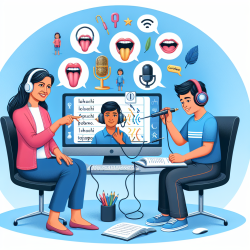In the realm of speech therapy, understanding and minimizing phoneme errors is crucial for effective communication. A groundbreaking study, "Judgments of Phoneme Errors Under Four Modes of Audio-visual Presentation," sheds light on how different audio-visual conditions affect the perception and judgment of phoneme errors. This research, conducted by James C. McNutt and colleagues, offers invaluable insights for speech therapists and educators, potentially revolutionizing approaches to speech therapy.
The study meticulously compared the reliability of judgments of phoneme errors between audio and video modes under two conditions: soundfield and headphones. The findings revealed that video presentations resulted in fewer judged phoneme errors and less variance, suggesting a more consistent and accurate perception of speech sounds. Conversely, audio modes led to a higher number of judged phoneme errors and greater variance, indicating a less reliable perception.
For practitioners in the field of speech therapy, these findings underscore the importance of incorporating video presentations into therapy sessions. The visual cues available in video can significantly enhance the accuracy of phoneme error detection, thereby improving the effectiveness of therapy. Here are several ways practitioners can implement these insights:
- Integrate Audio-Visual Materials: Develop or source audio-visual materials that emphasize the phonemes commonly misarticulated by clients. Use these materials to enhance clients' awareness and self-correction abilities.
- Customize Therapy Sessions: Tailor therapy sessions to include more video presentations, especially for clients struggling with phonemes that are difficult to articulate correctly. This could involve video recordings of correct articulations for clients to mimic and compare against their own attempts.
- Utilize Technology: Leverage technology platforms that support video interactions, such as video conferencing tools, for remote therapy sessions. This can help maintain the visual component of speech therapy, even when in-person sessions are not feasible.
- Encourage Self-study: Recommend or provide access to online resources with video content for clients to engage in self-directed learning and practice outside of therapy sessions.
- Conduct Research: Encourage further research on the impact of audio-visual aids in speech therapy to continually refine and enhance therapeutic techniques.
It's also crucial for practitioners to stay informed about the latest research and developments in the field. Engaging with studies such as the one conducted by McNutt and colleagues can provide evidence-based strategies that improve therapy outcomes. Furthermore, practitioners should consider the individual needs and preferences of their clients when integrating new methods into therapy sessions.
The implications of this study extend beyond individual therapy sessions. Educators and technology developers in the field of speech pathology can use these insights to create more effective learning tools and software. By prioritizing video-based content and interactions, these tools can better support speech therapists and their clients in achieving successful communication outcomes.
In conclusion, the study "Judgments of Phoneme Errors Under Four Modes of Audio-visual Presentation" offers compelling evidence for the benefits of video presentations in speech therapy. By incorporating these findings into practice, speech therapists can enhance the accuracy of phoneme error detection and improve the overall effectiveness of therapy. As the field of speech pathology continues to evolve, embracing audio-visual technology will be key to delivering high-quality, effective therapy.
To read the original research paper, please follow this link: Judgments of Phoneme Errors Under Four Modes of Audio-visual Presentation.










